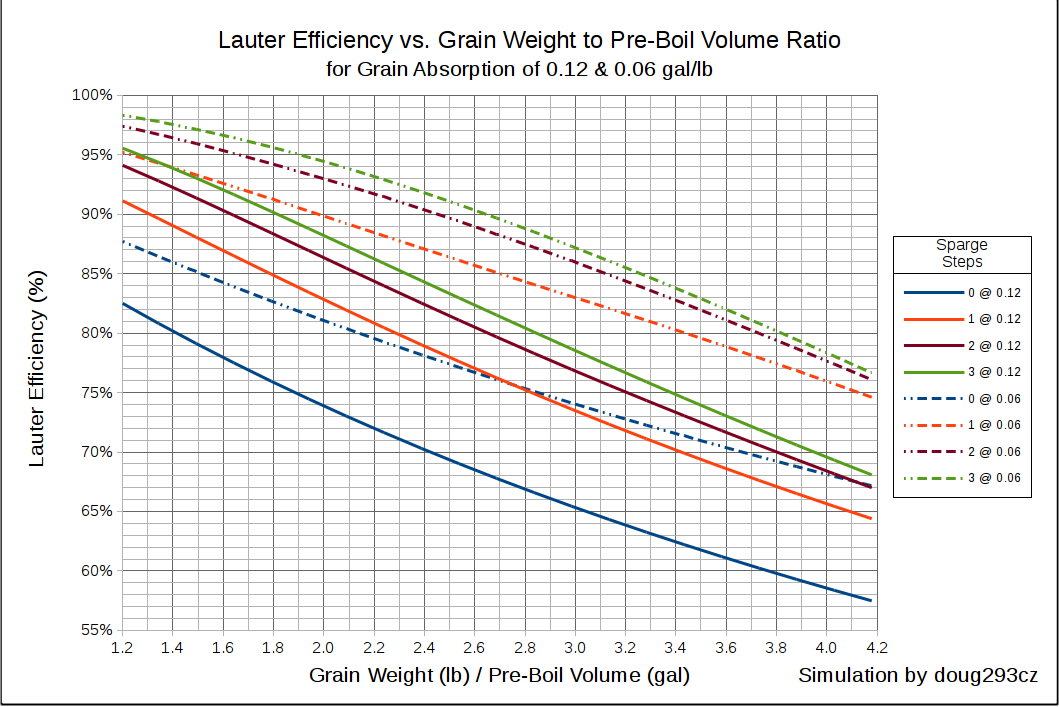luckybeagle
Making sales and brewing ales.
I'm currently brewing a Belgian style Tripel with a 25# grain bill (10.5 gallon batch, mostly pilsner malt) on my 15 gallon eHERMS system. After 8 batches on this system and 80 or so to my name, this was the first time I ever messed with my mash pH. I noticed it was high (6.2 about 10 minutes into the mash), so I added a few ML of Lactic Acid and reduced it to 5.5ish. I also treated my sparge water down to about 5.4-5.6 pH. The water coming from my tap is 7.4, and my efficiency has been poor, so I thought I'd start there.
I mashed at about 151F for 75 minutes and recirculated through my herms coil the entire time. I fly sparged to a 12 gallon preboil volume over the course of about an hour, stirred up the boil kettle and took a gravity reading. After adjusting for temperature, I came up with a preboil gravity of 1.064. This is 4 points lower than my intended preboil gravity at a conservative 78% efficiency. I thought for sure I'd land north of 80% and would have to dilute. My actual efficiency after taking these numbers into account is 73%. My previous batch was about 75% and a Trappist Single I brewed earlier this year was in the mid 80's.
It's strange to me that, on this system and with this process, I'm essentially getting my old batch sparge efficiency on a much more complex and time consuming system. I built it about 90% to specs of Kal's system (theelectricbrewery.com), and he's averaging 88 - 95% efficiency on his batches. Assuming the roller settings at my LHBS hasn't changed, what in my process is causing such crummy numbers? I'm slightly annoyed that they're unusually low, but really frustrated that I can't seem to hit my #s on any batch and need to make BU:GU, boil time and volume adjustments on the fly.
As low tech as batch sparging was, I'm thinking of going back to that method (on this system). Any thoughts from the forum wizards?
I mashed at about 151F for 75 minutes and recirculated through my herms coil the entire time. I fly sparged to a 12 gallon preboil volume over the course of about an hour, stirred up the boil kettle and took a gravity reading. After adjusting for temperature, I came up with a preboil gravity of 1.064. This is 4 points lower than my intended preboil gravity at a conservative 78% efficiency. I thought for sure I'd land north of 80% and would have to dilute. My actual efficiency after taking these numbers into account is 73%. My previous batch was about 75% and a Trappist Single I brewed earlier this year was in the mid 80's.
It's strange to me that, on this system and with this process, I'm essentially getting my old batch sparge efficiency on a much more complex and time consuming system. I built it about 90% to specs of Kal's system (theelectricbrewery.com), and he's averaging 88 - 95% efficiency on his batches. Assuming the roller settings at my LHBS hasn't changed, what in my process is causing such crummy numbers? I'm slightly annoyed that they're unusually low, but really frustrated that I can't seem to hit my #s on any batch and need to make BU:GU, boil time and volume adjustments on the fly.
As low tech as batch sparging was, I'm thinking of going back to that method (on this system). Any thoughts from the forum wizards?






